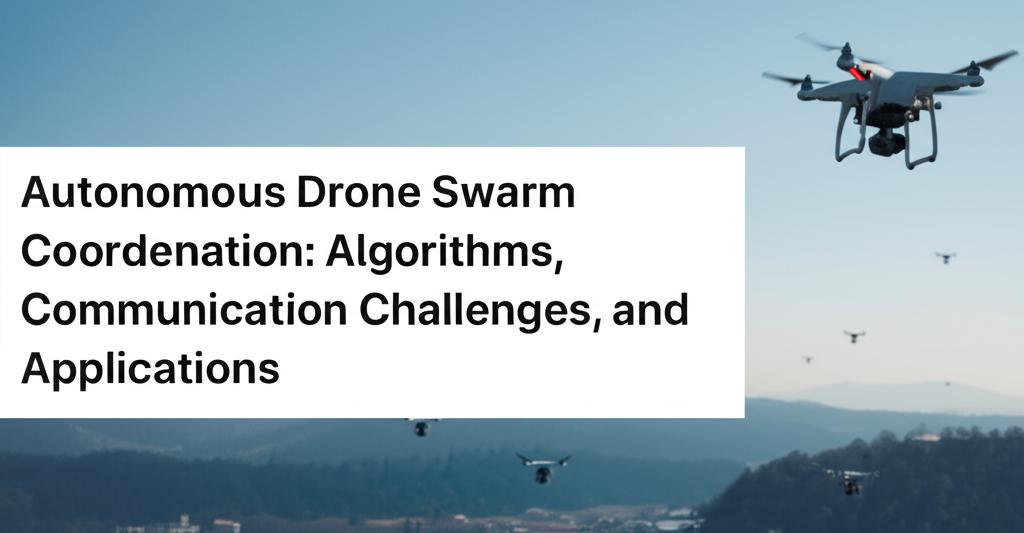Autonomous drone swarms represent a significant leap in robotics, moving beyond single-unit operations to coordinated groups of unmanned aerial vehicles (UAVs) working collaboratively. Inspired by collective behaviors in nature, like bird flocks or insect colonies, these swarms leverage sophisticated algorithms and communication systems to perform complex tasks with enhanced efficiency, resilience, and adaptability compared to individual drones. They often operate under decentralized or distributed control, allowing for autonomy and collective decision-making even without constant human intervention.
Algorithms Driving Coordination:The ability of drone swarms to operate cohesively relies on a variety of complex algorithms governing their behavior and interactions. Key categories include:
- Swarm Intelligence & Flocking Algorithms: Based on principles observed in nature (like bird flocking or ant colonies), these algorithms often involve simple rules for individual drones regarding cohesion (staying together), separation (avoiding collisions), and alignment (matching speed and direction with neighbors). Examples include Particle Swarm Optimization (PSO) and Ant Colony Optimization (ACO), which help optimize group movements and efficient pathfinding.
- Consensus Algorithms: These enable drones within the swarm to agree on collective decisions or shared states (like mission goals or environmental data) based on the information exchanged among them. Algorithms like Raft are used to ensure decision consistency across the network.
- Collision Avoidance: Crucial for safe operation, these algorithms use sensor data and communication to predict potential collisions with other drones or obstacles and adjust trajectories accordingly. Techniques can range from simple repulsion vectors based on proximity to more complex predictive models.
- Formation Control: These algorithms allow the swarm to arrange itself into specific geometric patterns (lines, circles, grids) and maintain that formation during movement, which can be optimal for tasks like scanning areas or creating displays.
- Path Planning and Navigation: Algorithms like A* or Dijkstra's are adapted for swarm use, enabling the group to plan optimal routes to a destination while navigating dynamic environments and avoiding obstacles.
- Task Allocation and Optimization: Algorithms distribute tasks among swarm members based on drone capabilities, current status, and mission requirements, ensuring efficient use of resources.
- Artificial Intelligence (AI) and Machine Learning (ML): Increasingly vital, AI/ML techniques enhance drone autonomy and coordination. Deep Reinforcement Learning (DRL), Multi-Agent Reinforcement Learning (MARL), Deep Q-Networks (DQN), and Proximal Policy Optimization (PPO) allow drones to learn optimal behaviors through interaction, adapt to unpredictable situations, improve flight efficiency, and collaborate more effectively in dynamic scenarios. Edge AI processes data directly on the drones, enabling faster real-time responses.
Control architectures can range from centralized (a single ground station controls all drones) to decentralized (drones communicate amongst themselves based on shared information with minimal central oversight) or fully distributed/autonomous systems where drones make independent decisions based on local data and swarm protocols.
Communication Challenges:Effective coordination hinges on robust communication, but drone swarms face several hurdles:
- Latency: Real-time coordination demands extremely low-latency communication. Delays can lead to synchronization errors, collisions, or mission failure, especially in dynamic environments or high-speed maneuvers.
- Reliability and Bandwidth: Swarms generate and exchange large amounts of data (positioning, sensor readings, intent). Maintaining reliable links, especially over distance or in environments with interference (RF congestion, electronic warfare), is challenging. Limited bandwidth can restrict data sharing.
- Scalability: As the number of drones in a swarm increases (potentially to hundreds or thousands), managing communication links, preventing interference, and ensuring efficient data dissemination becomes exponentially more complex.
- Security: Wireless communication links are vulnerable to jamming, spoofing, eavesdropping, and cyberattacks. Compromising the communication network can disable or hijack the entire swarm. Secure and encrypted communication protocols are essential.
- Interoperability: Ensuring seamless communication and data exchange between drones from different manufacturers or using different communication standards can be difficult, particularly in joint operations.
- Energy Constraints: Communication systems consume power, and drone battery life is often limited. Balancing communication needs with flight endurance is a key design consideration.
Researchers and companies are developing solutions like advanced mesh networking topologies (where drones relay data for each other), dynamic network restructuring, adaptive anti-jamming techniques, optimized communication protocols (like PIBS or platform-specific solutions), and edge computing to process data locally and reduce communication load.
Applications:The unique capabilities of autonomous drone swarms open up a wide range of applications across various sectors:
- Military and Defense: Swarms act as force multipliers for intelligence gathering, surveillance, reconnaissance (ISTAR), target acquisition, coordinated attacks (including "kamikaze" drones), electronic warfare, overwhelming enemy air defenses, and providing tactical support. They enhance situational awareness and can reduce risk to human soldiers.
- Public Safety and Disaster Response: Swarms can rapidly survey large disaster areas, search for missing persons (even in hazardous conditions), monitor wildfires, assess damage, deliver emergency supplies (medical, food), and enhance communication networks in compromised areas.
- Agriculture: Precision farming benefits from swarms performing tasks like monitoring crop health across vast fields, applying fertilizers or pesticides with high precision, and potentially even coordinated planting or harvesting.
- Entertainment: Drone light shows, while often centrally controlled rather than fully autonomous, demonstrate the potential for precisely coordinated aerial displays using large numbers of drones.
- Infrastructure Inspection: Swarms can efficiently inspect large structures like bridges, pipelines, power lines, and wind turbines, identifying potential issues faster and more safely than manual methods.
- Environmental Monitoring: Coordinated drones can track wildlife migration, monitor deforestation or pollution spread, collect atmospheric data, and map large ecosystems.
- Security: Autonomous swarms can provide persistent surveillance and perimeter defense for critical infrastructure, large events, or private properties, offering comprehensive coverage and rapid response capabilities.
- Logistics and Delivery: While still nascent, future applications could involve drone swarms coordinating complex delivery routes and schedules in urban environments.
As algorithms become more sophisticated, communication becomes more reliable, and AI integration deepens, the capabilities and applications of autonomous drone swarms will continue to expand, potentially transforming numerous industries and operations. However, addressing the technical, ethical, and regulatory challenges remains crucial for their widespread and responsible adoption.

